| 1 | Africa’s longest snake |
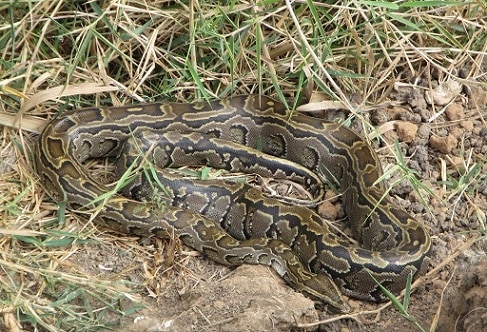
The snakes of Africa remain some of the most mysterious to this day. There are dozens of species with barely any research to their name at all, from the green watersnake of South Africa, to the Laurent’s tree snake of DRC. But ever since the Roman empire 2000 years ago, one fact has remained undisputed – that the African rock python is the continent’s largest snake.
This gargantuan species is found in the vast majority of sub-Saharan Africa, and is a habitat generalist which only avoids true deserts and rainforests. African rock pythons reach 5 metres with ease, and are divided into two closely related species: Python sebae of central and western Africa, and Python natalensis of southern and eastern Africa. These form 2 of the 10 “true” python species worldwide.
Another member is the ball python (Python regius), which is found in west African countries like Nigeria. This overlaps with the rock python in several countries, but is significantly shorter at an average, of just 1-1.5 metres.
African rock pythons have irregular blotchy patterns rather than finely ordered stripes. Their colours are mainly brown, beige and chestnut, with a paler belly. Not only do African rock pythons reach 6 metres on occasion, but they’re a particularly bulky python, easily beating the reticulated python (the world’s longest) and Indian python for sheer thickness.
| 2 | Tales of 10 metre monstrosities |
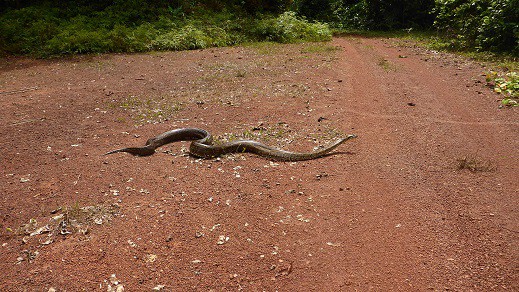
The largest rock pythons of all come from west Africa, with those in the south being smallest. The average adult rock python measures 3-3.53 metres, but over 5 metres is nothing exceptional, as they continue to grow their entire lives. Exactly how monstrous they can become is still a matter of debate. Tales of 10 metre brutes the size of a fallen tree have trickled out of villages, and stories of 9 metre snakes blocking paths are commonplace. Every local elder has his own story to tell, and even the largest reliably confirmed snake is mysterious, with so many records scattered around.
The most common claim is that K. H. Kroft shot dead a 7 metre African rock python in 1958, which had a 1.5 metre Nile crocodile in its stomach. A 7.5 metre monstrosity from Gambia is also referenced commonly, and 1932 saw the tale of Mrs Charles Beart, who supposedly shot dead a 9.81 metre rock python in the grounds of a school in Ivory Coast.
The growth rate of the rock python is like a backgarden weed. Those in captivity, with a plentiful food supply, can grow 10cm a month, reaching 2 metres after 1 year of life. One captive rock python reached 5.18 metres within 5.5 years.
| 3 | Diet: warthogs, gazelle, and crocodiles |
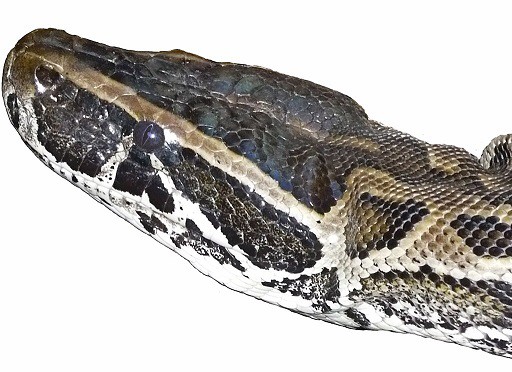
The diet of this snake consists of the entire cast of The Lion King. Its large size allows it to swallow antelopes, warthogs, white pelicans, monitor lizards and possibly young crocodiles with no worries. Rock pythons long held the official honour of the largest prey consumed by any snake: an 130 pound impala consumed by a 4.92 metre rock python (as reported in 1952). In 2017, this was broken by itself, when a rock python was spotted constricting and swallowing a 150 pound hyena. Most disturbingly, this rock python wasn’t particularly big – just 3.9 metres.
A 1966 report mentioned a 4.6 metre African rock python swallowing a Thompson’s gazelle, whose massive horns briefly spiked through its body. Monkeys are a popular prey, including red colobus monkeys. Adult rock pythons stick with these hefty meals, not bothering to hoover up many smaller animals like they could. A study found that no Python sebae over 1.55 metres had rats in its belly, whereas rats (particularly the greater cane rat) are the favourite meals of young rock pythons.
Though never seen, it’s believed that an adult human could be swallowed by a rock python. The average adult male has a 35-40cm shoulder span when pressed forward, which would be small enough to fit into a 5 metre snake.
| 4 | The legend of 1958 |
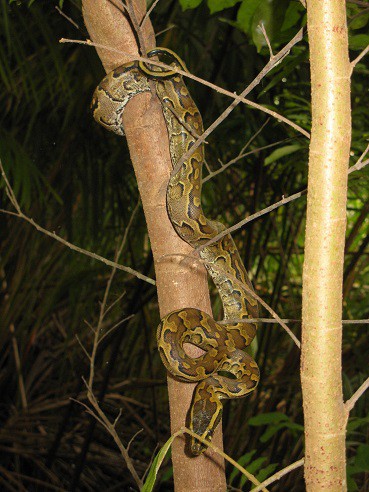
The rock python’s huge size means that they have almost no natural predators. The one exception (apart from mankind) is the Nile crocodile. Though rare, a long study in a Gambian nature reserve recorded 6 instances of Nile crocodiles attacking rock pythons.
One legendary tale involved Remy Van Lierde, ace flying pilot and hero of World War 2. Post war, van Lierde was assigned to the modern day Congo, and as he flew over the Katanga region in 1958, he spotted a truly gigantic serpent below.
His colleague snapped a photo, and van Lierde made 4 or 5 helicopter passes over the hole the python was lurking in. Lierde wasn’t known for exaggeration, and by extrapolating from the bushes below, he scientifically estimated its size to be 15.5 metres. Supposedly, it reared up angrily as the pilot descended, reaching 3 metres high, as though intending to attack the helicopter. Lierde described its colours as green and brown with a white underbelly; the green may have been a trick of the light, but the whiter belly fits with the rock python.
| 5 | Usually found near water |

African rock pythons can appear in forests, rainforests, savannah, semi-desert, grassy plains and even settlements. The one preference they show is for water, and they’re less attracted to farmland than their neighbour the ball python. Rock pythons often lurk in waterside reeds and plants, moving through the shallows silently, in order to ambush prey trotting past. A 2004 study found that 81% of tracked snakes were located with 10 metres of a stream or river.
For example, rock pythons are common in the Arusha national park of Tanzania, and guides know that the simplest way to find them is walking along river banks. The drier the region, the stronger the association with water will be, particularly in drier parts of their territory like Kenya. Across Africa, it’s believed that rock pythons have been aided by the installation of watering holes for livestock. This species is less active in the dry season, joining the party with the first flush of heavy rains.
Rock pythons are also strong tree climbers. They commonly take shelter in burrows, including those of aardvarks and warthogs.
| 6 | Shoves over prey with brute force |
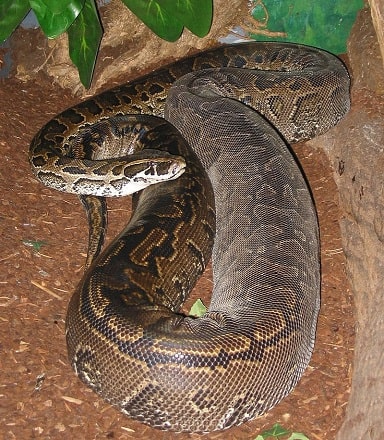
Body size is correlated with eggs in the snake world and African rock python lays a huge amount, normally 40 and sometimes 100. They can lay them in open grassland or rock piles, but one of their favourite spots is aardvark burrows, sometimes 7 metres beyond the entrance and 1 metre deep vertically.
Being a primitive family, the African rock python has pelvic spurs on its lower body, which are the last remnants of limbs possessed by their ancient ancestors. They also have thermoreceptive, heat-seeking pits which allow them to spot prey at night. Their hunting method is standard for pythons, mainly ambush where they pounce on prey walking past and slowly constrict. As the captured prey’s chest rises with breathing, the rock python tightens its coils.
The species lacks venom, but its mouth is filled with jagged teeth which curve backwards. For such a bulky snake, African rock pythons move extremely quickly. Furthermore, they’re extremely powerful, and strike with such force that they can tackle a 130 pound antelope to the hard earth.
| 7 | Man battles rock python in tree |
Crazy tales orbit the African rock python, in past, future and present. One story happened in the Kenyan village of Sabaaki in 2009, near the Indian coast. Farm worker Ben Nyaumbe was minding his own business when he accidentally stepped on an African rock python measuring 4.0 metres. The snake was enraged, and immediately began looping around the man’s body. At one point, Nyamumbe’s hands were trapped in coils, and the snake was preparing to swallow, so he took the only route available to him – he bit the snake’s tail. The scales were so sharp that Nyamube’s lower lip was cut open and bled. Nyamube freed himself, grabbed his mobile phone, and just managed to contact his employer, but the relentless python then dragged him up a tree.
The man ripped off his shirt and used it to smother the snake, to prevent it from swallowing him. Then his employer arrived with police and villagers in tow, who looped a rope around the snake and yanked it down from the tree. The raging python was captured by police, but disturbingly, it later managed to escape.
Whether 50% or 100% true (it made the BBC at least), this tale added another chapter to the annals of this giga-python. The Romans were also aware of rock pythons, as a finely crafted mosaic shows.
| 8 | Central and southern differences |
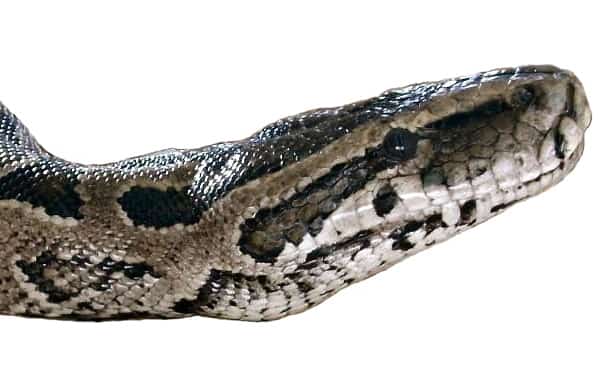
Some believe the central (Python sebae) and southern African rock pythons (Python natalensis) to be full species, while some call them subspecies. Either way, there are clear differences. The main one is that the southern version is smaller, though still a hefty brute. A study in South Africa covered 75 rock pythons, and found that the longest female was 4.34 metres. The longest reliably confirmed Python natalensis measured 5.8 metres, still long enough to swallow someone.
At a distance, few could tell, but zoom up close and the differences become obvious. Firstly, central African rock pythons have a noticeably bulkier head, independent of size. Python natalensis has a thinner, more elegant skull (as elegant as a hyena-swallowing python can be). Secondly, the overall colouration of southern rock pythons is similar, but slightly drabber. The northern version is brighter. Finally, python sebae has two thin white stripes extending downwards from its eye, contrasting against a mostly black face. With the southern rock python, the white patches extend much higher, absorbing and thus erasing the white stripes.
The central African rock python is the only one found in west African countries, such as Nigeria, Ghana and Togo. Python natalensis is found in countries like South Africa, Namibia, Zimbabwe and Mozambique. However, there’s a small area of overlap between the two in northern Tanzania and Kenya.
| 9 | Not a popular pet |
The neighbour of the rock python is the ball python (Python regius), with the two overlapping in places like Gambia and Nigeria. This species eats rats, and is beloved by farmers for pest control. It’s even worshipped as a deity in wooden temples. This species only reaches 1.2 metres, yet it far outstrips the rock python in commonality. A study found that Nigeria hosts 6.6 ball pythons per hectare, but only 0.1-0.2 rock pythons per hectare. Togo boasts 0.839 to 2.77 ball pythons per hectare, while rock pythons only manage 0.1. This is a rarer species, though still commonly sighted.
Likewise, the African rock python is barely common in the reptile trade at all. Ghana exports thousands of ball pythons per year, but only 50 rock python skins annually, mainly used in ethnic art. The species has never become popular, partly because of their aggressive temperament, and partly because of their huge size, which makes upkeep difficult. But another reason is simpler: there are no flashy colour morphs, just variations of brown, chestnut and beige. Rock pythons can’t compete with the bright red Malaysian blood python for attractiveness.
| 10 | Unusually attentive to eggs |
Unlike its Asian kin, the African rock python is incapable of shivering to warm its eggs (thermogiensis). This pushes the species down a riskier route. Rock python mothers still coil around their eggs to warm them, but will abandon them occasionally to bask in the sun. This warms her body up to 40 degrees, and they even darken their scales via a melanin accumulation in order to absorb more UV rays. After several hours, she’ll then return to the eggs and transfer her newly acquired warmth.
The risky part is that mother rock pythons don’t eat during this process. They sometimes take their duties so far that they die, as their fat reserves plummet to skeletal levels. From mating to pumping out eggs to the eggs finally hatching, the entire breeding process can take 6 months, during which females can lose 40% of their body weight. Consequently, rock pythons don’t lay eggs very often, usually every two or three years. This might be why ball pythons are so much more common.
Male rock pythons are also extremely tenacious – one followed a female it desired for 3 months. At birth, rock python hatchlings already measure 45-60cm.
